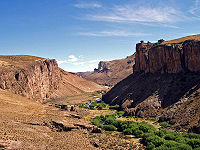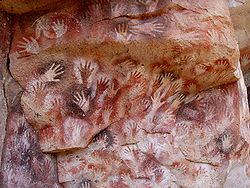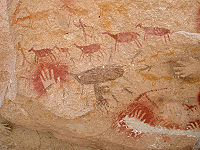- Cueva de las Manos
-
Cueva de las Manos, Río Pinturas * UNESCO World Heritage SiteCountry Argentina Type Cultural Criteria iii Reference 936 Region ** Latin America and the Caribbean Inscription history Inscription 1999 (23rd Session) * Name as inscribed on World Heritage List
** Region as classified by UNESCOCueva de las Manos (Spanish for Cave of the Hands) is a cave or a series of caves located in the province of Santa Cruz, Argentina, 163 km (101 mi) south of the town of Perito Moreno. It is famous (and gets its name) for the paintings of hands, made by the indigenous inhabitants (possibly forefathers of the Tehuelches) some 9,000 years ago. The composition of the inks is mineral, and thus cannot be carbon dated, so the age of the paintings was calculated from the remains of bone-made pipes used for spraying the paint on the wall blocked by the hand.
 Canyon at the Pinturas River, view from the caves
Canyon at the Pinturas River, view from the caves
The cave lies in the valley of the Pinturas River, in an isolated spot in the Patagonian landscape. It is most easily reached by a gravel road (RP 41), which leaves Ruta 40 3 km north of Bajo Caracoles and runs 46 km northeast to the south side of the Pinturas Canyon. The north side of the canyon can also be reached by rough, but shorter, roads from Ruta 40. A 3 km path connects the two sides of the canyon, but there is no road link.[1]
The main cave measures 24 m (79 ft) in depth, with an entrance 15 m (49 ft) wide, and it is initially 10 m (33 ft) high. The ground inside the cave has an upward slope; inside the cave the height is reduced to no more than 2 m (7 ft).
The images of hands are often negative (stencilled). Besides these there are also depictions of human beings, guanacos, rheas, felines and other animals, as well as geometric shapes, zigzag patterns, representations of the sun, and hunting scenes. Similar paintings, though in smaller numbers, can be found in nearby caves. There are also red dots on the ceilings, probably made by submerging their hunting bolas in ink, and then throwing them up. The colours of the paintings vary from red (made from hematite) to white, black or yellow. The negative hand impressions are calculated to be dated around 550 BC, the positive impressions from 180 BC, and the hunting drawings to be older than 10,000 years[2]
Most of the hands are left hands, which suggests[says who?] that painters held the spraying pipe with their dexterous hand.
Cueva de las Manos has been listed as a World Heritage Site since 1999.
References
- ^ Moon Travel Guide, Argentina
- ^ Indígenas Argentinos, ISBN 987947910-6 (Spanish)
External links
- Cueva de las Manos in the UNESCO WHC website
World Heritage Sites in Argentina Northwest 
Mesopotamia Guaraní Jesuit Missions of San Ignacio Miní, Nuestra Señora de Santa Ana, Nuestra Señora de Loreto and Santa María la Mayor1 · Iguazú National Park
Cuyo Pampas Patagonia Cueva de las Manos, Río Pinturas · Los Glaciares · Península Valdés
1 Shared with BrazilCoordinates: 47°09′19″S 70°39′19″W / 47.15528°S 70.65528°W
Categories:- Archaeological sites in Argentina
- World Heritage Sites in Argentina
- Santa Cruz Province
- Caves of Argentina
- Rock art in South America
Wikimedia Foundation. 2010.



